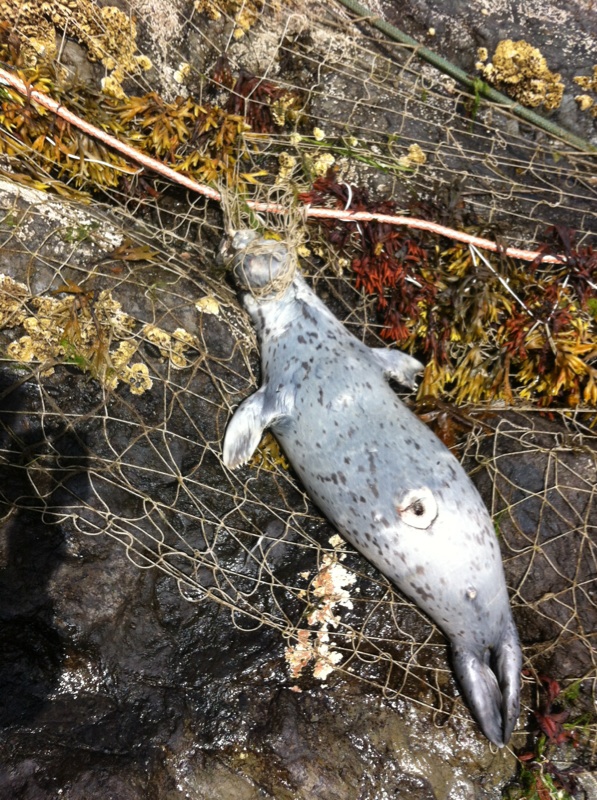Seal, Fur Seal, and Sea Lion Entanglement Response
NOAA Fisheries authorizes emergency response to seals, fur seals, and sea lions with life-threatening entanglements.
Entanglements are a significant cause of injury or mortality to seals, fur seals, and sea lions—a group of marine mammals called pinnipeds—throughout the world. They can become entangled in active fishing gear and marine debris (plastic packing bands, large rubber bands from pot fisheries, garbage, balloons, etc.), which may cause serious injury and death from wounds, additional energy expenditure, and drowning. Ingestion of fishing gear and marine debris can also lead to injury and death.
Responding to entangled seals and sea lions is often difficult or impossible due to logistical constraints, including inaccessibility of the animal (such as animals hauled out on rocky shorelines like the Northern fur seal above), inability of the capture teams to relocate the entangled animal (as it may still be capable of swimming long distances), or inclement weather, in addition to animal and human safety concerns.
NOAA Fisheries-Authorized Responders
Organizations that respond to entangled seals and sea lions are typically members of the National Marine Mammal Stranding Network or working under a NOAA Fisheries Permit issued to the Marine Mammal Health and Stranding Response Program. Only responders who have been authorized by NOAA Fisheries and who have the appropriate training, experience, and equipment should attempt pinniped entanglement response.
All pinnipeds in the United States are protected by the Marine Mammal Protection Act, and some species are listed as threatened or endangered under the Endangered Species Act.
Deciding to Respond
Because intervention can be dangerous for the animals and responders, entanglement response for pinnipeds is only attempted if the entanglement is causing—or has the potential to cause—a life-threatening injury, and the potential risks of capture are necessary for the survival of the animal.
NOAA Fisheries staff, in consultation with experienced responders, biologists, experts, and veterinarians, carefully review cases with experts that have observed the animals in the field to determine if the entanglement is life threatening. Once an entanglement is determined to be life threatening, the next step is to discuss and plan the most appropriate method of intervention. Most interventions involve capture, handling, and entanglement response techniques. If circumstances allow, animals may be given antibiotics in the field before they are released to help minimize infection. However, in some cases, they are brought to an authorized rehabilitation facility for further treatment and care. If an injury is too severe—and the animal’s pain and suffering is too great—trained responders may determine that euthanasia is the most humane outcome.
If intervention is not an option (e.g., the animal is in an unsafe location or weather conditions are not safe), the animal may be monitored to determine whether an intervention may be possible in the future (e.g., the animal moves to a more suitable area for rescue, the animal becomes lethargic and more approachable, or weather improves).
Specialized Tools and Techniques
Network partners have developed and refined several tools and techniques for pinniped entanglement response that increase responder and animal safety. Entangled pinnipeds are typically, but not always, captured when they are hauled out on land. Entanglement responders often use herding equipment, capture nets, restraining gear, and specialized cutting tools and are trained in proper techniques for safe capture, restraint, and removal of gear from various pinniped species. Some responses may involve tools on poles similar to large whale entanglement response equipment.
In some circumstances, remote sedation is used if the animal is too large to physically restrain or in an area where an unsedated capture effort might cause too much disturbance to nearby non-entangled animals. Although methods that use remote sedation (typically through sedatives delivered in darts) are effective and have advanced significantly in the past decade, these types of responses require specialized training and come with additional risks to both responders and animals.
What Can You Do?
If you come across an entangled seal or sea lion, please report it immediately, and remain at least 50 yards (150 feet) away from the animal. The Marine Mammal Health and Stranding Response Program relies on reports by the public to conduct its vital work to save animals in distress and understand causes of injuries and mortalities.
Only experienced responders who have been authorized by NOAA Fisheries and who have the appropriate training, experience, equipment, and support should attempt marine mammal entanglement response.
Learn more about what to do if you see an entangled marine mammal >



